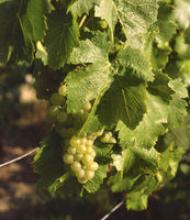Chardonnay is notorious or celebrated, depending on whom you ask, for the grapes' ability to reflect distinct differences in taste based on the terroir, the composition of the soil the vines grow in. Chardonnay had a enormous burst in popularity in the late 1980s and early 1990s, especially in California, where growers, perhaps too enthusiastically, planted thousands of acres in Chardonnay grapes. That "glut," as some see it, led to many wine drinkers rejecting Chardonnay, or at least California Chardonnay, out of hand. Chardonnay is one of the most abundant grapes, grown in just about every region that grows grapes. Chablis refers to Chardonnay from the Chablis region in the far northern corner of Burgundy, a region whose chill climate and particular limestone, chalk, and marl soil creates a dry wine known for both taste and aroma. In France Chardonnay is a key grape for Champagne, but it flourishes in the U.S., especially California, in South Africa, as well as Australia and New Zealand. In recent years, Chile and Argentina have had success with Chardonnay. Chardonnay is also very popular as a blend with other white wines, especially Chenin blanc, and Sémillion.
University of California at Davis researchers have determined via DNA testing that the Chardonnay grape is a cross between Pinot and Gouais Blanc (still sometimes called Heunisch) grapes. The theory behind this very successful cross is that Romans brought Gouais Blanc with them from the Balkans, and cultivated it enthusiastically in Eastern Gaul, now known as Eastern France. Later French-speaking medieval and renaissance peasants favored the grape, which was often cultivated in vineyards very near their aristocratic feudal lords Pinto vines. So the initially cross was likely natural, but because the offspring vines distributed hybrid vigor, the cross was enthusiastically propagated, and resulted in a suite of closely related offspring, including Chardonnay, Auxerrois, Peurion and a handful of others. There are now a very large number of French-developed clones of Chardonnay, many of which appear to be very much suited to new world climates like those in Washington and Oregon, especially in the Willamette valley.
Two common wine making techniques that very much affect Chardonnay whether or not malolactic fermentation (which converts the harder, and pungent-tasting malic acid to the softer lactic acid, responsible for the "buttery" quality of many Chardonnays, versus the "sour" or green apple quality) is used, and whether or not oak is part of the fermentation process (in the form of oak chips added to the wine) or the aging process, in terms of the actual barrels (American or French oak, new or aged oak, and how much the oak is charred, for instance, all make a difference). The time of harvest also makes a difference; riper grapes are sweeter, and that can lead to a higher alcohol content. Other, more controversial techniques include adding other ingredients, often in very small quantities, to the fermenting wine. For such a very traditional grape, the resulting wine, and its production, has become increasingly controversial in the last twenty years, with a bewildering array of very different but very emphatic opinions about every aspect.
Many people associate summer with Chardonnay, and that's certainly affected the food pairings. The source, and production methods of Chardonnay affect its flavors and aromas so much that some Chardonnays can be paired with roast chicken or grilled sea food, while others, especially the oaky versions, may be perfect for smoked fish or mild artisan cheeses. more acidic Chardonnays may work very well with spicy Asian influenced cuisines. There are so very many Washington wineries with a Chardonnay (Riesling-centric Pacific Rim is the only Washington winery I can find without a Chardonnay), that it's not difficult to find just the right one for you and your menu.
